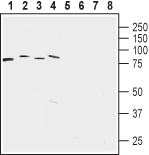Overview
- Peptide (C)KELSKTGDEKYIEE, corresponding to amino acid residues 587-600 of rat LETM1 (Accession Q5XIN6). Intracellular, mitochondrial matrix.

 Western blot analysis of rat brain membrane (lanes 1 and 5), mouse brain membrane (lanes 2 and 6), human acute lymphoblastic leukemia (MOLT-4) (lanes 3 and 7) and human colorectal adenocarcinoma (HT-29) cell lysates:1-4. Anti-LETM1 Antibody (#ANT-183), (1:1500).
Western blot analysis of rat brain membrane (lanes 1 and 5), mouse brain membrane (lanes 2 and 6), human acute lymphoblastic leukemia (MOLT-4) (lanes 3 and 7) and human colorectal adenocarcinoma (HT-29) cell lysates:1-4. Anti-LETM1 Antibody (#ANT-183), (1:1500).
5-8. Anti-LETM1 Antibody, preincubated with LETM1 Blocking Peptide (#BLP-NT183).
- Nowikovsky, K. et al. (2012) J. Gen. Physiol. 139, 445.
LETM1 (leucine zipper–EF hand-containing transmembrane region), a protein with a key role in mitochondrial volume homeostasis through regulation of K+/H+ exchange (KHE), is involved in respiratory chain biogenesis and in the pathogenesis of seizures in the Wolf–Hirschhorn syndrome (WHS). LETM1 has been recently proposed to catalyze mitochondrial H+/Ca2+ exchange, which would imply a role in mitochondrial Ca2+ homeostasis as well.
LETM1 contains a hydrophobic N-terminal portion spanning the inner membrane and a large hydrophilic portion including the C-terminus located in the matrix. The primary amino acid sequence of the C-terminal part predicts at least two coiled-coil domains and two Ca2+-binding EF hand–like motifs. However, the EF hands differ from canonical EF hand motifs by several residues, and the α helices are not directly flanking the Ca2+-binding loop. The amino acid sequence of yeast LETM1 proteins lacks these putative Ca2+-binding EF hand motifs. The N-terminal region of the LETM1 protein superfamily displays a mitochondrial targeting sequence and a single transmembrane domain. The latter is highly conserved in all orthologues and is rich in proline residues.
In mitochondria, absence of LETM1, causes decompensation of electrophoretic K+, resulting in matrix swelling causing, in turn, increased mitophagy and/or cell death1.
Application key:
Species reactivity key:
Anti-LETM1 Antibody (#ANT-183) is a highly selective antibody directed against an epitope of the rat protein. The antibody can be used in western blot analysis. It has been designed to recognize LETM1 from human, mouse, and rat samples.
